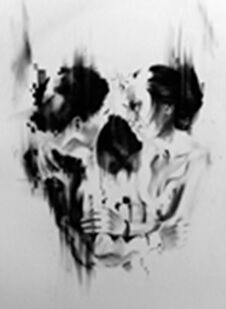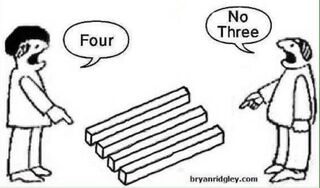Bias
Ferguson: Why Is It so Hard for Us to Agree on the Truth?
Four cognitive illusions that illustrate why we don't all see the same reality
Posted December 8, 2014
We're constantly looking at the world around us. As we do so, we record millions of images. Then we interpret what they mean and organize them into categories. No doubt most of us understand that our interpretations vary as a function of our culture, our politics, and all sorts of other individual and group differences.
But it's not just the organization that differs. Our very perception of reality is often quite different from that of others, even when we set our eyes upon the very same thing. This is partly why talking about the situation in Ferguson is as frustrating as it is, even with our family members. Below are four sets of perceptual illusions that illustrate a few of the ways that different people (or even the same person!) may see the same social reality differently.
1. Background/Foreground or What's the Focus?
Our mind seems unable to focus on foreground and background at the same time. Often, this is adaptive. We know what we want to foreground and our brain accommodates our preferences. But sometimes, it is the so-called background that might be more important, or at least equally important. What do you see in the images below? Keep looking...you should be able to see something else, as well.

Importantly, what we see as foreground versus background is also relevant socially. A few days ago, high school students in my local community were holding a rally outside the high school to protest the grand jury decisions in the police shooting deaths of Michael Brown and Eric Garner. The rally, which was approved by school officials, was designed to take place on school grounds but spilled over to the street in front of the school. While the students were on the street, a woman attempted to drive a car through the group of students [see video]. Students responded by hitting the car and apparently did some damage to the glass. The event was reported by the local newspaper:
Some of them [students] walked into Crescent Drive in front of the school. As that occurred, a vehicle travelled through the crowd. At least one of the students struck the vehicle’s window and caused damage to the glass, according to police, who were called to the scene. [see full article]
Notice how the article places the damage to the car in the foreground. The car was not driven through the group of students, it just somehow "travelled through the crowd." But when it comes to the damage to the car, it didn't just happen. Rather "one of the students struck the vehicle's window."
One could have just as legitimately focused on the fact that someone tried to drive a car through a group of protesting students. Arguably, that's not only the more interesting story but also the one that's more newsworthy, but if we get our information from just a single source, our understanding of the truth will be necessarily limited by a particular reporter or a particular media source's intentional or unintentional focus.
In many ways, the entire public discourse/debate about Ferguson can be seen as a disagreement about what is (or should be) the primary focus and what is (or should be) the background. For the police and their supporters, the focus is on the threat that Brown and others pose to both their own safety and to that of the community they patrol. For those who are rallying and otherwise protesting their deaths, Brown's and Garner's behavior is background to the real story, which is how police dehumanize (by seeing them as a threat rather than as a person) people of color in general and Black men in particular.
Notably, for both sides, the incidents involving Brown and Garner are representative of a larger morality issue. Thus, we hear the language of "thugs" and "black rage" -- words intended to carry negative connotation -- used to describe what some see as the criminal nature of certain communities, even though the same language can, just as easily, be used to describe those who support and maintain the structures that create dissatisfaction and aggression in those communities, as demonstrated in this piece on "white rage". Even something as lacking in subtlety as rage, it seems, depends on the focus of one's attention.
2. Distance
When we are far away from something, we see the broad strokes but not the fine lines.

If we look at the image on the left, most of us will probably see two women. But if you move far enough away from the screen, you'll probably be able to see something very different. This is true not only in regard to physical distance but social and emotional distance as well. Thus, African Americans often see certain things differently from white Americans in regard to race, because they are much closer to the many ways that racism and racial bias operate in our society. Interestingly, though most of us would not presume to tell someone standing much closer that they are seeing things incorrectly, when it comes to racism, this is exactly what often happens.
To be sure, it's possible to get so close to something that it is no longer possible to clearly see the entirety of it. Maybe some white people think African Americans are so close to racism that they are no longer able to see where it starts and ends so that their entire reality seems racist. The point here is not to discern who is seeing more clearly -- this will surely differ person to person and situation to situation -- but to point out that our social and emotional distance to something can have a powerful impact on our perceptions.
3. Social Location
It's not just how close one is to something that matters. The place from which we're looking -- the point of view -- matters too. In the image below, both of the men are perceiving and interpreting their reality accurately, yet their understanding of what is "true" is different because their point of view is different.

As with distance, this is as true in regard to differences in social location as it is for physical location. Thus, gender, race, religion, social class, sexual orientation, political ideology, and many other social categories that shape our experiences give us all different points of view, which, in turn, determine, how we see (and make sense of) the same events.
Notably, these categories are not independent of each other. Rather, each particular combination represents a different social location and, therefore, a different point of view. This is why respectability politics are more likely to be asserted by folks like Bill Cosby, Charles Barkley, and the handful of other Blacks who have the good fortune to either be part of the top 1% or realistically aspire to get there.
Cosby and Barkley aren't wrong in the way that neither of the two cartoon characters above is wrong, and politics of respectability have a place in the public discourse. But let's be clear that they see their reality from the point of view of their social location and those who are located elsewhere are likely to have a different experience of race, especially in the context of policing. And they aren't wrong either.
4. Projection
When the situation is not ambiguous, there is not a whole lot of interpretation that needs to happen. But when there is ambiguity, a person can only determine what he/she sees by imposing (i.e., projecting) his/her self onto the content.

This is the theoretical principle behind projective tests, like the Rorschach (ink blot) and the Thematic Apperception Test (TAT). That is, what a person sees in an ink blot reveals quite a bit about the person and nothing at all about the blot, because the blot is so ambiguous that it could be practically anything. Get enough ink blots and the data points start to cluster into themes (e.g., insecurity, aggression) that reveal something important about the person's personality.

Situations such as the one in Ferguson are ambiguous enough to function like an inkblot. Often, we see not so much what is actually there but what we (often unconsciously) expect or want to be there. That is, when the situation is sufficiently ambiguous, rather than seeing another person, we see some aspect of ourselves. And we respond accordingly, not unlike the artist in the image below.
The appeal of this illusion is the discovery that the rabbit's self-portrait can, indeed, accurately represent the duck. But just as the "paint myself" strategy is unlikely to work for every studio session with every subject, projection is similarly unlikely to represent reality accurately in most circumstances.
The problem is that projection is an unconscious and, therefore, unintentional process. As a result, it is difficult to intentionally overcome it. But difficult is not impossible. They key seems to be to understand ourselves well enough to predict what we are likely to project onto others. Tools developed by psychologists, such as the Implicit Association Test, can help us do that by revealing to us our implicit biases, including racial biases, which we have (often unintentionally) picked up from society.
This is important because implicit biases tend to impact our behavior in all sorts of ambiguous situations. In the case of police officers, it is the best explanation for why officers report seeing a gun instead of the innocuous object (e.g., phone, soda bottle) the person was actually carrying. The consequences, as described in this piece in Mother Jones, can be tragic.
But it is not just police officers who fall victim to this kind of projection. We all do it. In fact, much of racism these days is perpetrated not by self-proclaimed racists but by well-meaning Americans who, unaware of their racial bias, perceive an ambiguous, high-stress event in a way that is consistent with their bias, even if their conscious mind actively rejects the same bias.
Psychological studies show that we can teach ourselves to override implicit bias, but that's a topic for another article.
__________________________________________
For more racial analysis of news and popular culture, join the | Between The Lines | Facebook page and follow Mikhail on Twitter.
 This work is licensed under a Creative Commons Attribution-NoDerivs 3.0 Unported License.
This work is licensed under a Creative Commons Attribution-NoDerivs 3.0 Unported License.




